Migraine Relief: Techniques Beyond Medication
Migraines are more than just headaches. They’re intense, often debilitating episodes that can include nausea, visual disturbances, and sensitivity to light and sound. While medications can be effective, they’re not the only option. Many people find relief using natural or alternative methods—either alone or alongside medication. In this article, we’ll explore various non-medical techniques to manage migraines and improve your quality of life.
Understanding Migraines
Before diving into relief techniques, it’s important to understand what migraines are. A migraine is a neurological condition, often marked by:
-
A throbbing or pulsing headache (usually on one side)
-
Nausea or vomiting
-
Visual auras (flashes, spots, or blind spots)
-
Sensitivity to light, sound, and smells
Migraines can last from a few hours to several days. Triggers vary from person to person but can include stress, sleep changes, certain foods, weather changes, and hormones.
Why Look Beyond Medication?
While prescription drugs and over-the-counter (OTC) medications can be effective, they don’t work for everyone. Some people experience side effects or find that medicine alone doesn’t fully relieve symptoms. Others may prefer to avoid daily medication. That’s where non-medication techniques come in.
Let’s look at proven methods for migraine relief that don’t involve pills.
1. Keep a Migraine Diary
Tracking your migraines can help you identify and avoid triggers. A migraine diary should include:
-
Date and time of the migraine
-
What you ate that day
-
Sleep patterns
-
Stress levels
-
Weather conditions
-
Physical activity
By spotting patterns, you can make lifestyle changes that may prevent future attacks.
2. Manage Stress
Stress is one of the most common migraine triggers. Reducing stress doesn’t mean removing it entirely but learning how to cope better. Here are a few methods:
Deep Breathing
Practice slow, deep breaths for a few minutes. It can help calm the nervous system.
Meditation and Mindfulness
Even a few minutes of daily meditation can reduce anxiety and tension that may lead to migraines.
Progressive Muscle Relaxation (PMR)
This involves tensing and then slowly relaxing each muscle group in the body, promoting overall relaxation.
3. Get Consistent Sleep
Irregular sleep—either too much or too little—can trigger migraines. Good sleep hygiene includes:
-
Going to bed and waking up at the same time each day
-
Creating a dark, quiet sleep environment
-
Avoiding screens before bed
-
Limiting caffeine late in the day
A regular sleep schedule helps keep your brain chemistry balanced.
4. Stay Hydrated
Dehydration is a simple but common migraine trigger. Drink plenty of water throughout the day, especially if you’re active or live in a hot climate. A good rule of thumb is to drink half your body weight in ounces of water daily (e.g., if you weigh 150 lbs, aim for 75 oz of water).
5. Watch Your Diet
Certain foods and beverages can set off migraines. Common dietary triggers include:
-
Aged cheeses
-
Chocolate
-
Processed meats
-
Alcohol (especially red wine)
-
Caffeine (in excess or withdrawal)
Try an elimination diet—remove potential trigger foods for a few weeks, then reintroduce them one at a time to see if symptoms return.
Eating regular meals and not skipping breakfast can also help keep blood sugar stable, which may prevent migraines.
6. Apply Cold or Warm Compresses
Many people find relief from migraine pain with temperature therapy. Try:
-
A cold compress on your forehead or neck during a migraine for numbing pain relief
-
A warm compress if your muscles are tight or you feel tension building
Experiment to see which works best for you.
7. Try Essential Oils
Some essential oils have been shown to help relieve migraine symptoms. Peppermint oil, for example, can offer a cooling sensation and ease tension. Lavender oil is known for its calming effects.
How to use:
-
Dilute with a carrier oil (like coconut oil) and apply to temples or back of the neck
-
Inhale using a diffuser
Note: Essential oils may not be safe for everyone, especially pregnant women or people with allergies. Use them with caution.
8. Practice Gentle Exercise
While intense workouts can sometimes trigger migraines, gentle exercises like yoga, walking, or swimming may help prevent them.
Benefits:
-
Reduces stress
-
Improves blood flow
-
Helps regulate sleep
-
Releases endorphins (natural painkillers)
Start slow and listen to your body. Yoga, in particular, combines movement with breathing, making it a great option for migraine prevention.
9. Acupuncture
Acupuncture, an ancient Chinese practice involving the insertion of thin needles into specific body points, has been shown to reduce the frequency and severity of migraines in some people.
The theory is that acupuncture balances energy flow (or “Qi”) and stimulates the body’s natural healing processes.
Many patients find it relaxing and effective—though it may take several sessions to notice a difference.
10. Biofeedback
Biofeedback is a technique that teaches you to control certain body functions, like heart rate, muscle tension, and skin temperature.
With sensors connected to your body, you get real-time feedback and learn how to relax those systems. Over time, this can reduce migraine frequency and intensity.
You’ll usually need guidance from a trained therapist to learn the technique.
11. Cognitive Behavioral Therapy (CBT)
CBT is a type of talk therapy that helps you recognize and change negative thought patterns and behaviors. It’s been shown to help people with chronic migraines by:
-
Reducing stress and anxiety
-
Encouraging healthier habits
-
Improving coping strategies
Even a short course of CBT can make a difference in managing pain.
12. Massage Therapy
Tension in the neck, shoulders, or jaw can lead to migraines. Regular massage therapy can help by:
-
Loosening tight muscles
-
Improving circulation
-
Promoting relaxation
You can also try self-massage techniques, like rubbing your temples or gently stretching your neck.
Final Thoughts
Migraines are a complex condition, and what works for one person may not work for another. The good news is that you don’t have to rely solely on medication. By using a combination of techniques like stress management, diet changes, physical activity, and relaxation methods, many people find lasting relief.
If you suffer from frequent or severe migraines, talk to your healthcare provider before starting new treatments. A customized plan that includes both medical and non-medical strategies may offer the best results.
Remember: You have options. And with a little patience and experimentation, you can find a path to a more comfortable, migraine-free life. For those who want to explore additional strategies to support a healthier lifestyle, consider checking out more in-depth self-care resources at venzec.icu.





